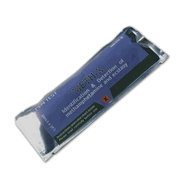Before you sign the paperwork on a new place, it’s smart to know about past residents and the home’s history—your new nest might have a sordid past that could hurt your family’s health. While home meth production has declined since 2004, the DEA reports that thousands of homes seized since then could still be contaminated.1 Plus, only 27 states require this information to be disclosed, and laws vary widely between each location.2
The worst part is, once purchased, the home is yours to clean. Local services and home inspectors often offer testing and cleaning, but the process can be expensive and cost thousands of dollars. Learn how to tell if your home was a meth house and what to do about it.
Be Suspicious of Strong Odors
It’s normal for old homes to smell musty, but meth labs leave a signature scent. So put your nose to the ground and sniff for any suspicious smells like ammonia, rotten eggs, or vinegar. These smells are a red flag for any property, so be sure to ask the hard questions before buying.
Note Unsanitary Conditions
Meth labs aren’t exactly known for their cleanliness. If you walk into a house that looks messy and run-down, it’s a good indicator that something might be amiss. Deep stains on the carpet and walls can also be a strong signal of drug use in the home. That’s not to say that every messy house is a former meth house, but be skeptical if you encounter a home that’s excessively dirty.
Review Registered Meth Houses
Spend some time researching the property online. The Drug Enforcement Administration (DEA) maintains a National Clandestine Laboratory Register that’s available to the public. This database stores properties reported as meth houses in all 50 states. It might not have every meth house in the US listed, but it’s a great place to start your research. Even if the address you’re interested in is clean, the database gives you a better idea of where the meth labs in your area are.
Ask Your Neighbors
If you’re new to the area, your neighbors can be a well of helpful information. If they’ve lived in the neighborhood for a while, they’ll likely have important details about the previous owners and any suspicious activities that could have taken place there.
Go to the Police Station
Who knows the negatives of a neighborhood better than the police? Local officers have a lot of information that can help steer you in the right direction. They’ll know everything from the number of arrests to the kinds of disturbances and criminal activities that have taken place. If the house has drug-related incidences, make sure meth wasn’t involved. You can also check out online sources to help you find out how safe your neighborhood is.
Be Wary of Suspiciously Low Prices
Everyone loves a discount, but if the price feels too good to be true, it might be. Not every foreclosure or short sale is shady, but a low price on an amazing property could be due to long-term damage caused by meth. Before finalizing the sale on a foreclosure, do some research and check its history so you know it’s a good deal.
Buy a Test Kit
Meth houses aren’t always run-down and easily recognizable. A newly refinished house might not have any visible signs of prior meth production, but you never know what could be under the surface. If you suspect the property has been used to cook meth, ask your realtor or inspector for a test. You can also conduct your own drug residue test with a home testing kit that produces results instantly or one that you send off to a professional lab.
A Final Word of Advice
Purchasing a home is a life-changing investment, so don’t rush. Meth labs occur by the thousands all over the country, and it’s likely that there are many more undocumented cases. Save your family time, money, and health hazards by testing and researching any home for meth before you finalize the deal.
Sources:
1. Drug Enforcement Administration, “2017 National Drug Threat Assessment”
2. Realty Times, “Are You Obligated to Disclose Previous Meth Contamination on Your Property?”
The post How to Tell If You Are Buying a Meth House appeared first on SafeWise.


No comments:
Post a Comment